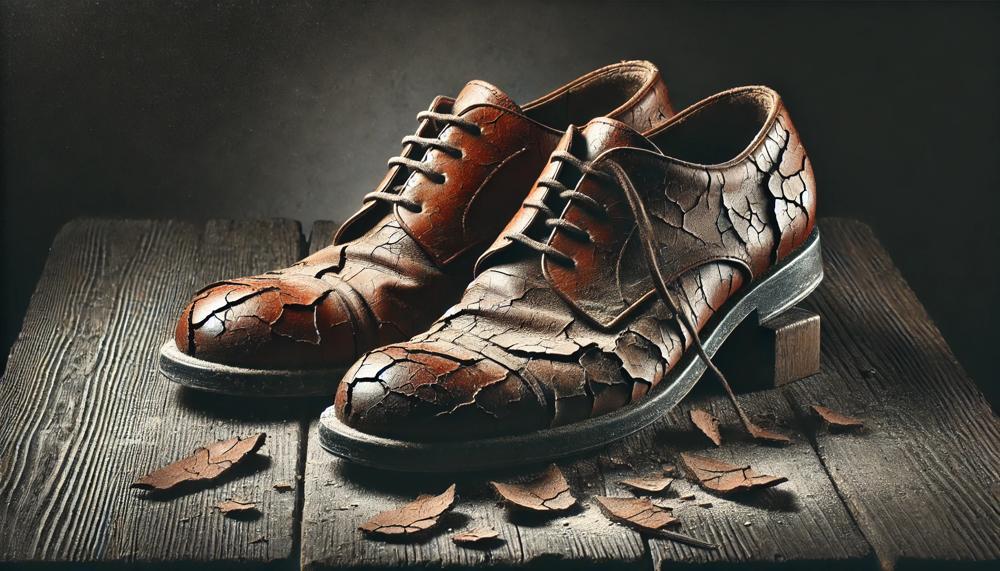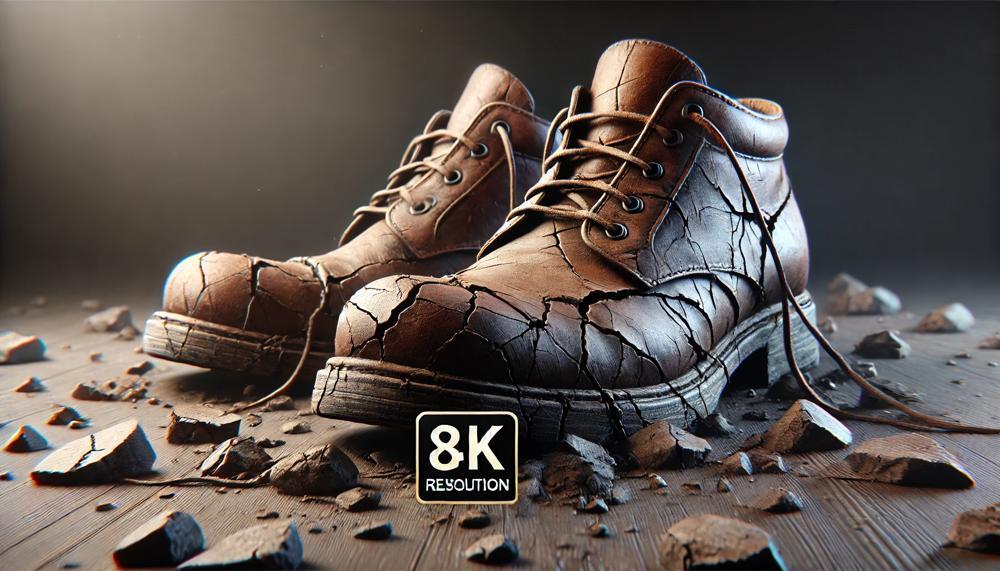Yes, cracked leather shoes can indeed be repaired. While leather shoes are valued for their durability and style, they can succumb to cracks from drying out and regular wear. But don’t worry, with the right approach, these beloved items can be restored to their former glory.
If you’ve noticed unsightly cracks developing in your leather footwear, this article will guide you through a straightforward process to fix them. We’ll cover essential steps including cleaning, conditioning, filling, sanding, and finally, polishing your shoes to perfection. Whether you’re a seasoned DIYer or new to shoe care, this guide is crafted to provide you with practical skills and tips to extend the life and beauty of your leather shoes.
Main Takeaways:
- Understanding Damage: Learn why leather cracks and how to assess the severity of shoe damage.
- Essential Tools: A list of the necessary tools you’ll need to start the repair process.
- Step-by-Step Guide: Easy-to-follow instructions for each stage of the repair.
- Preventative Tips: Advice on how to prevent future cracks and maintain leather shoe longevity.
By the end of this read, you’ll be equipped with the knowledge to not only repair your cracked leather shoes but also keep them in tip-top condition for years to come. Join us as we dive into the world of DIY leather shoe repair.
What Causes Leather Shoes to Crack?
Contents [show]
Leather shoes can crack for various reasons, which can be disheartening when it affects your favourite pairs. Here’s a deeper look into the common causes and prevention techniques for cracking in leather shoes:
Common Causes of Leather Shoes Cracking
- Natural Aging and Dryness: Leather, being a natural material, loses moisture and becomes dry over time. This dryness leads to the leather becoming brittle and eventually cracking.
- Exposure to Harsh Elements: Regular exposure to intense sunlight, heat, and water leads to faster degradation of the leather. Water causes the leather to swell and shrink, which stresses the material.
- Chemical Damage: Using harsh cleaning agents not specifically designed for leather can strip away natural oils and moisture, leading to premature cracking.
- Improper Fit: Shoes that don’t fit properly can create undue stress and distort the leather, leading to cracks from constant bending and stretching.
How to Prevent Leather Shoes from Cracking
- Regular Maintenance: Clean and condition your leather shoes regularly. Use a high-quality leather conditioner to maintain moisture and flexibility in the leather.
- Appropriate Storage: Avoid storing leather shoes in direct sunlight or in extremely dry or humid environments. Use shoe trees to help maintain the shape of the shoes and prevent creases.
- Weather Consideration: In wet conditions, opt for waterproof shoes or protect your leather shoes with a water-resistant spray. This prevents water from penetrating the leather and causing damage.
- Proper Fit: Ensure your shoes fit well without being too tight or too loose. This reduces the strain on the leather during wear.
| Cause | Explanation | Prevention |
| Natural Aging | Leather loses moisture over time. | Regular application of leather conditioner. |
| Exposure to Elements | Sun, heat, and water degrade leather. | Avoid extreme conditions and use protective sprays. |
| Chemical Damage | Harsh cleaners remove essential oils. | Use cleaners specifically designed for leather. |
| Improper Fit | Excessive stress from poor fit causes cracks. | Choose shoes that fit correctly to minimize stress. |
By understanding these causes and implementing the prevention tips, you can extend the life of your leather shoes and keep them looking their best.
Regular care is crucial, not only to maintain their aesthetic but also to ensure their longevity and comfort.
How to Fix Cracked Leather Shoes: Step by Step Guide
When mending cracked leather shoes, the aim is to restore their durability and aesthetics through a precise, yet simple procedure. Below, I outline a methodical approach, ensuring that your leather footwear receives the necessary care to extend its lifespan.
| Step 1: Clean the Leather | Begin by gently brushing the leather surface with a soft-bristled brush to remove dirt and debris. Apply a high-quality leather cleaner with a soft cloth in circular motions. This initial step is vital for preparing the leather for further treatment. |
| Step 2: Condition the Leather | Post-cleaning, nourish the leather by applying a leather conditioner. This product helps in replenishing the natural oils lost over time, preventing further deterioration and preparing the surface for crack repair. |
| Step 3: Apply Filler | Use a specialized leather filler to address the cracks. Apply it meticulously, ensuring it gets well into the cracks for optimal repair. Allow the filler to dry completely, which typically takes about 24 hours. |
| Step 4: Sand the Surface | Once the filler is dry, lightly sand the area with fine-grit sandpaper to smooth any excess filler and create a level surface. Be gentle to avoid damaging the leather. |
| Step 5: Polish for Shine | Wipe the sanded area with a dry cloth to remove any dust. Then, use a soft cloth to apply a leather polish in circular motions. This final step enhances the shine and provides a protective layer. |
For additional detailed insights on leather care products and techniques, you might find the Wikipedia page on Leather useful.
How to Repair Leather Shoes with Torn Leather

Repairing leather shoes with torn leather involves meticulous attention to detail and the use of specific materials to ensure a lasting repair. Here’s a guide on how to achieve this:
Assess the Damage
Gather Materials
| Material | Use |
| Leather glue | Adheres the leather pieces securely |
| Matching leather | Covers and reinforces the damaged area |
| Scissors | To cut the leather accurately |
| Cloth | To smooth out glue and remove excess |
Clean and Prepare the Area
- Clean the damaged area thoroughly to remove any dirt and debris. This ensures the glue adheres well.
Apply Glue and Press
- Apply a moderate amount of leather glue to the edges of the tear. Press the edges together firmly to close the gap.
Patching
- Cut a piece of leather that matches the shoe’s leather, ensuring it’s slightly larger than the tear. Place this patch over the area and apply glue underneath and around the edges.
Smooth and Finish
- Use the cloth to press down on the patch smoothly, eliminating any air bubbles and excess glue. Allow it to dry completely as per the glue manufacturer’s instructions.
Final Touches
- Once dry, condition the leather to help it blend seamlessly and restore its natural look.
This repair not only extends the life of your shoes but also maintains their aesthetic appeal, proving both economical and practical. Regular conditioning and careful storage away from extreme conditions can further protect your leather shoes from future damage.
How to Restore Leather Shoes at Home
Restoring cracked leather shoes at home is a manageable task that involves a series of steps designed to clean, repair, and revitalize your cherished footwear. The process ensures not only an improved appearance but also enhances durability and comfort.
Necessary Steps to Restore Cracked Leather Shoes
| Step | Description | Tools/Products Needed |
| Clean the Shoes | Start by removing surface dirt and debris using a soft brush. Apply a leather cleaner with a soft cloth to thoroughly clean the leather, prepping it for repair. | Soft-bristled brush, leather cleaner, soft cloth |
| Condition the Leather | Apply a quality leather conditioner to moisturize the leather, which helps to prevent future cracks and allows for easier application of the filler. | Leather conditioner |
| Apply Leather Filler | Use a leather filler to fill in the cracks. Apply it in thin layers, allowing it to dry thoroughly between applications. Sand lightly if necessary to achieve a smooth finish. | Leather filler, fine-grit sandpaper |
| Color and Polish | Once the filler is dry and smooth, apply a shoe cream that matches your shoe color. Finish by buffing with a soft cloth to a desired shine. | Shoe cream, soft cloth |
| Maintain Regularly | Regular maintenance with leather conditioner and careful storage will extend the life of your shoes and prevent future cracks. | Leather conditioner |
How to Prevent Leather Shoes and Boots from Cracking
Leather shoes and boots, cherished for their durability and style, require regular maintenance to prevent cracking, which can diminish both their appearance and lifespan. Here’s how you can keep your leather footwear in prime condition:
Regular Cleaning and Conditioning
Begin by gently cleaning your leather shoes with a suitable leather cleaner to remove dirt and debris. After cleaning, apply a high-quality leather conditioner, like Venetian Shoe Cream or Cobbler’s Choice Leather Conditioner. This routine should be performed a few times each year, or more frequently based on usage.
Proper Storage
Store your leather shoes in a cool, dry place away from direct sunlight, which can degrade and dry out the leather, leading to cracks. Use shoe trees made from cedar, which absorb moisture and help maintain the shape of the shoes.
Avoid Excessive Exposure to Elements
Protect your leather footwear from prolonged exposure to harsh weather conditions. When necessary, use water repellents specially designed for leather to provide an additional layer of protection against rain or snow.
Conclusion
Revitalizing cracked leather shoes is not just about repair—it’s about restoring life to your cherished footwear. Cracks in leather emerge primarily from natural wear, environmental stress, and chemical exposure. Fortunately, these blemishes can be reversed with a thoughtful approach, ensuring your shoes look and feel as good as new.
Starting with a meticulous cleaning to remove dirt and debris, the process transitions to conditioning, using premium products to reintroduce moisture and flexibility to the parched leather. The application of a specialized filler then precisely addresses the cracks, filling them thoroughly. A careful sanding smooths the surface, preparing it for the final flourish—a high-quality polish that not only enhances the shoe’s luster but also seals and protects the leather from future harm.
Moreover, regular maintenance is key to the longevity of leather shoes. Preventative measures, like using appropriate cleaning products and avoiding harsh conditions, shield the leather from future cracks and preserve its integrity.






